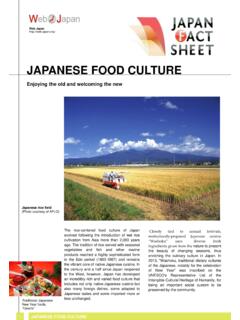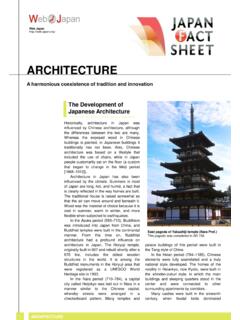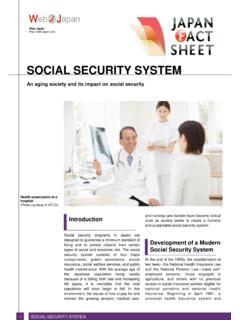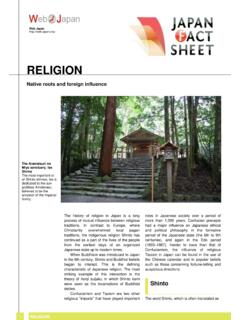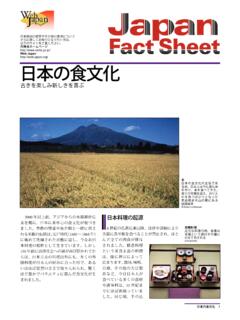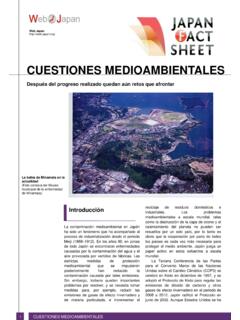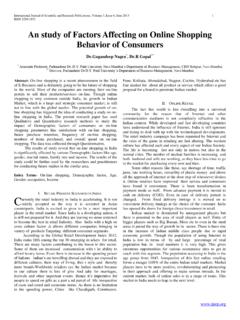Transcription of Ministry of Foreign Affairs Website ... - Japanese culture
1 Japanese FOOD CULTURE1 The rice-centered food culture of Japan evolved following the introduction of wet rice cultivation from Asia more than 2,000 years ago. The tradition of rice served with seasonal vegetables and fish and other marine products reached a highly sophisticated form in the Edo period (1600-1868) and remains the vibrant core of native Japanese cuisine. In the century and a half since Japan reopened to the West, however, Japan has developed an incredibly rich and varied food culture that includes not only native- Japanese cuisine but also many Foreign dishes, some adapted to Japanese tastes and some imported more or less unchanged. In the centuries following the introduction of Buddhism to Japan in the 6th century, laws and imperial edicts gradually eliminated the eating of almost all flesh of animals and fowl.
2 The vegetarian style of cooking known as shojin ryori was later popularized by the Zen sect, and by the 15th century many of the foods and food ingredients eaten by Japanese today had already made their debut, for example, soy sauce (shoyu), miso, tofu, and other products made from soybeans. Around the same time, a formal and elaborate style of banquet cooking developed that was derived from the cuisine of the court aristocracy. Known as honzen ryori, it is one of the three basic styles of Japanese cooking along with chakaiseki ryori (the cuisine of the tea ceremony meal) and kaiseki ryori. Enjoying the old and welcoming the newHonzen ryoriAn example of this formalized cuisine, which is served on legged trays called honzen. KodanshaJAPANESE FOOD CULTUREFor more detailed information on Japanese government policy and other such matters, see the following home of Foreign Affairs cultivation and consumption of rice has always played a central role in Japanese food culture .
3 Almost ready for harvesting, this rice field is located near the base of the mountain Iwakisan in Aomori Prefecture. Aomori prefectureJAPANESE FOOD CULTURE2 With an emphasis on the artistic presentation of fresh, seasonal ingredients, the tea meal married the formalities of honzen ryori to the spirit and frugality of Zen. Kaiseki ryori developed in its present form in the early 19th century and is still served at first-class Japanese restaurants known as ryotei and at traditional Japanese inns. While retaining the fresh seasonal ingredients and artful presentation of earlier styles, kaiseki meals have fewer rules of etiquette and a more relaxed atmosphere. Sake is drunk during the meal, and, because the Japanese do not generally eat rice while drinking sake, rice is served at the end.
4 Appetizers, sashimi (sliced raw fish), suimono (clear soup), yakimono (grilled foods), mushimono (steamed foods), nimono ( s i m m e r e d f o o d s ) , a n d aemono (dressed salad-like foods) are served first, followed by miso soup, tsukemono (pickles), rice, Japanese sweets, and fruit. Tea concludes the meal. Although most Japanese people have few opportunities to experience full-scale kaiseki dinners, the types and order of foods served in kaiseki ryori are the basis for the contemporary full-course Japanese sushi that most people are familiar with today vinegared rice topped or combined with such items as raw fish and shellfish developed in Edo (now Tokyo) in the early 19th century. The sushi of that period was sold from stalls as a snack food, and those stalls were the precursors of today s sushi s first substantial and direct exposure to the West came with the arrival of European missionaries in the second half of the 16th century.
5 At that time, the combination of Spanish and Portuguese game frying techniques with a Chinese method for cooking vegetables in oil led to the development of tempura, the popular Japanese dish in which seafood and many different types of vegetables are coated with batter and deep the reopening of Japan to the West in the mid-19th century, many new cooking and eating customs were introduced, the most important being the eating of meat. Although now considered a Japanese dish, sukiyaki beef, vegetables, tofu, and other ingredients cooked at the table in a broth of soy sauce, mirin (sweet sake), and sugar was at first served in Western-style restaurants. Another popular native dish developed in this period is tonkatsu, deep-fried breaded pork cutlets. Created in the early 20th century using Indian curry powder imported by way of England, Japanese curry rice (kare-raisu) became a very popular dish; it contains vegetables and meat or seafood in a thick curry sauce that is served over ingredient choices available at supermarkets and other food stores in all but the most isolated rural districts of Japan are so varied that on any given day a home-cooked dinner could contain an incredible variety of dishes of various national origins.
6 Even so, native Japanese food is still the norm, and a Japanese meal at home will generally have white rice, miso soup, and tsukemono Bento shopChains of shops like this one sell a variety of Japanese box lunches known as bento. The English name box lunch notwithstanding, bento are often eaten for dinner as well. Many shops are take-out only, but some have tables available. Kodansha InternationalSushi restaurantAlthough tables are also available, customers tend to sit at the counter where they can see the fresh fish and other seafood ingredients laid out in the cooled, glass-covered cases. Selections are called out directly to the nearest sushi chef. Miyagi prefectureThe contemporary dinner tableNaturalized importsSushi Some of the many types of nigirizushi, in which hand-molded portions of vinegared rice are topped with slices of raw fish, shellfish, and other ingredients.
7 A small dab of wasabi ( Japanese horseradish) is usually placed between the rice and the topping. KodanshaJAPANESE FOOD CULTURE3pickles. The multiple dishes that accompany these three vary widely depending on the region, the season, and family preferences, but candidates include cooked vegetables, tofu, grilled fish, sashimi, and beef, pork, and chicken cooked in a variety of ways. Popular alternatives to native Japanese fare include Chinese-style stir-fried meat and vegetable dishes and Korean-style grilled beef and pork. More adventurous cooks may try their hand at American, French, Italian, and other ethnic dishes. Selections particularly popular with children include spaghetti, hamburgers, and the curry rice mentioned many families continue to eat home-cooked meals every night, the greatest change taking place in eating habits in recent decades has been the replacement of home-cooked dishes with food prepared outside the home.
8 Sushi, Chinese and Japanese noodle dishes, and Japanese -style box lunches (bento) have long been available via home delivery (demae) in towns and cities, and now pizza and many other dishes can also be ordered. In addition, supermarkets have many prepared foods such as sushi, tempura, and fried chicken to purchase and take home, and the spread of convenience stores into all but the most remote areas of Japan has made a wide variety of pre-cooked bento-type meals available to almost s most famous contribution to global food culture sushi is generally eaten at sushi restaurants where customers sit at the counter and call out their orders item by item to a sushi chef. There are also very popular chains of conveyer-belt sushi restaurants where you grab small plates of two sushi off the conveyer belt in front of you or call out a special order if you do not see what you want on the belt.
9 Unlike Japanese restaurants abroad, which often serve a range of different types of Japanese food, restaurants in Japan generally specialize in a single type, such as sushi, tempura, shabushabu (thin slices of beef cooked at the table by dipping into a simmering broth), sukiyaki, unagi (grilled eel), soba and udon noodles, etc. The main exceptions to the specialization rule are the chains of family restaurants, which usually serve a range of Japanese , Western, and Chinese dishes. Two types of restaurants which are found in large numbers all over Japan but which are not considered native Japanese are ramen and yakiniku restaurants. Ramen restaurants serve generous helpings of Chinese-style ramen noodles in large bowls with broth (flavored with soy sauce, miso, salt, etc.)
10 , roast-pork slices, and various vegetables (bean sprouts, scallions, etc.), and many people also order gyoza (Chinese dumplings) to accompany their ramen. At yakiniku restaurants, which are based on Korean-style barbeque, guests cook bite-sized pieces of beef, other meats, and vegetables over a charcoal or gas grill at the table. Most large cities also have a considerable number of other Foreign -food restaurants serving French, Italian, Indian, Chinese, Korean, and other cuisine, and in Tokyo an almost unlimited selection of the world s food is available. At the opposite end of the price spectrum from elegant kaiseki ryotei and French restaurants are the food stalls that are still a familiar sight in some urban districts and at festivals and other outside events where many people gather.
